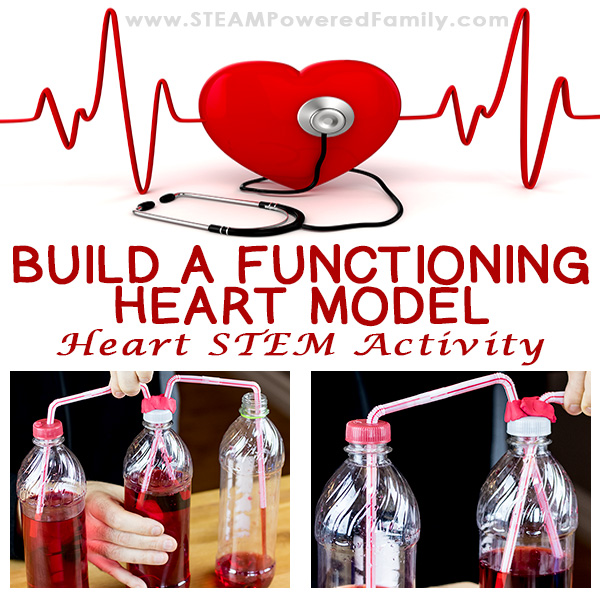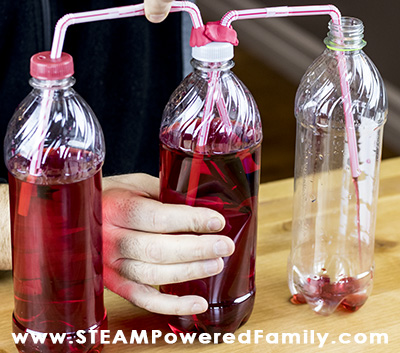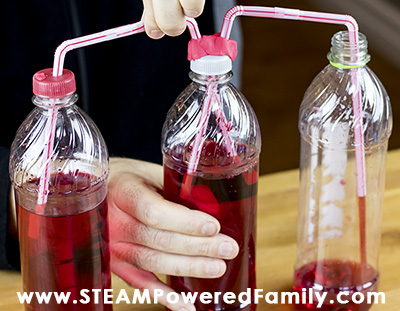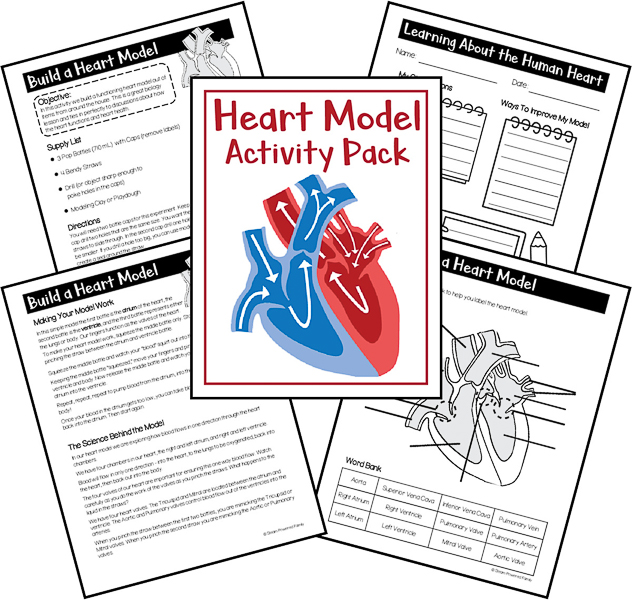Build A Functioning Heart Model
February is Heart Month which means it is the perfect time to bring some heart science to your lessons. In this activity we built a functioning and unique heart model out of items we had around the house. It was a great biology lesson and lab that tied in perfectly to our discussions about how the heart functions and heart health.
Build a Beating Heart Model

Disclaimer: This article may contain commission or affiliate links. As an Amazon Influencer I earn from qualifying purchases.
Not seeing our videos? Turn off any adblockers to ensure our video feed can be seen. Or visit our YouTube channel to see if the video has been uploaded there. We are slowly uploading our archives. Thanks!
I have a heart condition that has plagued me most of my adult life. I’ve undergone heart surgery and likely have more cardiac surgeries in my future. So talking about heart health is something that happens a lot around here. I’m often struggling with attacks and issues due to my heart. It’s an ever present concern and something that can derail our day with no warning.
Despite having lots of discussions about “mommy’s bad heart”, we’ve done very little in formal lessons on the heart. It is my plan to do some virtual heart dissections, but I wanted something more hands-on to start. So for heart month this year we decided to do some fun heart STEM activities.
Whenever we talk about the heart the kids immediately run and pull out their stethoscope. They love listening to their heart, the dog’s heart, my heart. Then they run and jump and get all excited before listening again.
Heart Model Video
Check out this video of our heart model. If you can’t see the video, please turn off your adblockers as they also block our video feed.
Heart Unit Studies and Printables
Unlock this free printable for STEAM Powered Family members!
For this lesson we recorded our heart beats (you can grab our heart science activity pack by joining STEAM Powered Family below).
Want to dive in deeper and turn this into a fantastic unit study on the heart? Purchase our complete Heart Model Activity Pack from our Shop or Teachers Paying Teachers. The heart activity pack comes with a full classroom license to use with all your students.
LISTENING TO THE HEART AND A LITTLE MATH
We tried feeling our heart beat on our wrists and at our throat, but the easiest for the kids was to use the stethoscope.
Using a stop watch we counted our heart beats for 10 seconds. Then we did a little math and had the kids multiply their answer by 6 to get their heart beats per minute. For my youngest, who is just learning multiplication, we found it easier to count heart beats for 6 seconds and multiply by 10.
The kids had fun trying different activities from yoga and meditation to slow their heart rate, to running and jumping to speed up their hearts.
EXAMINING HOW BLOOD FLOWS
Next we talked about the parts of the heart and how blood flows through the parts of the heart, plus lungs and body. We discussed how the heart works like the engine for our body pumping blood constantly to keep our organs functioning. We also discussed what is broken in my heart. For me it’s a circuit issue, where the electrical impulses that control the beating of my heart misfire. At some point I may require a pacemaker, so we talked about how I might get an engine to keep my engine going!
ENGINEER A WORKING HEART MODEL

Finally it was time to put our engineering hats on and design a working model of the heart.
To build our heart model we used:
3 x Pop bottles (710 mL) with caps, labels removed.
4 x Bendy straws
3 Cups of water
Food colouring
Tape
Modeling clay or play dough
Drill (or other sharp pokey for making holes in the caps)
DIRECTIONS FOR HEART MODEL
You will need 2 bottle caps for this experiment. Keep the third one as a back up. In the first cap drill two holes that are the same size. You want the holes to be just big enough for the straws to slide through. In the second cap drill one hole that is straw sized. The second should be smaller. If you drill both straw sized (like we did), you can use some modeling clay to make the second hole a little smaller.
In a pitcher, mix your water and food colouring to create your “red blood”. The exact amount of water is not important.
Take two straws, stretch and bend them to create a 90 degree angle. Slide one straw into the other straw (pinch one to make it smaller so it slides in), then tape up the join. Repeat with the second set of straws.

Place your three bottles on the table. Fill the first two with your water to about 80% full. Leave the third one empty.
On the first bottle place the cap with one straw hole and one small hole. On the middle bottle place the cap with two straw holes. Leave the third bottle without a cap.
Carefully slide the straws through the bottle caps. Place clay or play dough around the straw bases on the middle bottle to make an airtight seal with the bottle cap. You are now ready to put your heart model to work!
MAKING YOUR HEART MODEL WORK
In this simple model the first bottle is the atrium of the heart, the second bottle is the ventricle, and the third bottle represents either the lungs or body. Our fingers function as the valves of the heart.
To make your human heart models work, squeeze the middle bottle only. Start by pinching the straw between the atrium and ventricle bottle. Squeeze the middle bottle and watch your “blood” squirt out into the body.

Keeping the middle bottle “squeezed” move your fingers and pinch the straw between the ventricle and body. Now release the middle bottle and watch your blood move from the atrium into the ventricle.

Repeat, repeat, repeat to pump blood from the atrium, into the ventricle then out to the body!
Once your blood in the atrium gets too low, you can take blood from the “body” and add it back into the atrium. Then start again.
EXPLORING THE SCIENCE
Your heart rate is how fast your heart beats. We measure this as beats per minute. The easiest way to do this is to count how many times your heart beats in ten seconds, then multiply the number by 6 (60 seconds in a minute) to get your heart rate.
Heart rate is affected by many things. It varies by person, but also each person experiences variations in their heart rate every day. Many things can affect heart rate including age, health, activity, caffeine, sugar and more.
In our heart model we are exploring how blood flows in one direction through the heart chambers. We have four chambers in our heart, the right and left atrium, and left and right ventricle. Blood will flow in only one direction, it travels from the right side of the heart, to the left side of the heart. Specifically blood travels from the body into the heart, to the lungs to be oxygenated, back into the heart, then back out into the body.
The valves of our heart are important for ensuring this one way blood flow.
The human heart has four valves: aortic valve, pulmonary valve, tricuspid valve and mitral valve.
The tricuspid and mitral are located between the atrium and ventricle. The aortic and pulmonary valves control blood flow out of the ventricles into the arteries. When you pinch the straw between the first two bottles, you are mimicking the tricupsid or mitral valves. When you pinch the second straw you are mimicking the aortic or pulmonary valves.
Watch carefully as you do the work of the valves as you pinch the straws. What happens to the liquid in the straws?
Learn more about Heart Anatomy
Visit our shop to explore this printable mini lesson on human heart anatomy, plus many other human body systems printables.







